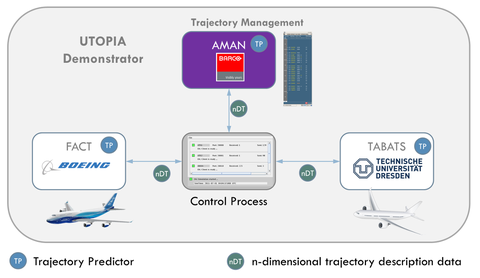UTOPIA - Universal Trajectory Synchronization for Highly Predictable Arrivals Enabled by Full Automation
UTOPIA (Universal Trajectory Synchronization for Highly Predictable Arrivals Enabled by Full Automation) was funded by EUROCONTROL as part of the SESAR Workpackage E (WP-E) from 2011 until 2013. It was a joint effort of Boeing Research & Technology Europe, Barco-Orthogon and TU Dresden acting as project coordinator.
The final project presentation held at Eurocontrol Experimental Center (EEC) premises, Bretigny, France, can be found here.
Project Information
Clients: Eurocontrol, SJU
Partners: Boeing Research & Technology Europe und Barco-Orthogon GmbH
Duration: 28 Monate, Mai 2011 - September 2013
Project Description
UTOPIA studied the consequences arising from the continuous increase in delegating capacity and safety critical traffic management functions to automated systems while integrating new types of airspace user. The solution proposed in UTOPIA is articulated in three innovative areas:
- Study uncertainty sources and their propagation including the potential of system disruptions by introducing so-called n-dimensional aircraft trajectories to allow consistent data handling,
- Advanced trajectory management algorithms and ground synchronisation functions acting as decision support to both systems and users, and
- Using a formal language for trajectory data transmission and trajectory synchronisation protocols for heterogeneous systems and users in an automated environment. Its objective was to provide a better understanding of trajectory management functions in the above mentioned areas to efficiently manage heterogeneous traffic by considering the increasing presence of autonomous ATM systems and agents.
UTOPIA focused on the design of algorithms allowing safe and orderly merge of heterogeneous traffic into a major airport hub (e. g. Frankfurt Main) surrounded by an extended Terminal Manoeuvring Area (TMA). Sequencing and merging were executed by an autonomous arrival management function, which was derived from an operational AMAN. The converging traffic flows into the hub airport consisted of heterogeneous airborne systems, in particular holding both advanced, UTOPIA-type and legacy flight management systems, representing airspace users with different synchronisation and protocol capabilities. Technically, the developed UTOPIA demonstrator proved to be a robust test environment to study highly automated air traffic management concepts with emphasis on, but not limited to, arrival management functions, uncertainty source modelling, and heterogeneous traffic configuration analyses. The state of the art operational procedures like holdings and path stretching were extended by studying RTA/CTA approaches.
Simulation environment
In the course of the project, a demonstration environment has been created to evaluate the developed algorithms and concepts. The simulation environment consists of four main components:
- Barco-Orthogon Arrival Manager (AMAN)
- Future ATM Concept Testbench (FACT) by Boeing Research & Technology Europe (BRTE)
- Testbench for Agent-based air traffic simulation (TABATS) by TU Dresden
- Demonstrator Control Process (DCP) by Barco Orthogon
While FACT and TABATS act as air traffic simulations, simulating the aircraft behaviour using highly accurate performance and FMS models, the Arrival Manager acts as ground-based trajectory management tool providing autonomous arrival management. The DCP connects all three components similar to a SWIM implementation and ensures proper synchronization between the clients.

Design of the UTOPIA simulation environment
Outcome
The key findings from the UTOPIA project are summarised as follows:
- Economy: When airspace users receive a required time of arrival (RTA) entering the extended 3 hour horizon TMA, a reduction of fuel consumption of up to 9% could be measured.
- Transmission: The required communication bandwidth nearly doubled for the RTA advisory scenarios compared to non-RTA scenarios.
- Capacity: The introduction of sophisticated unmanned aerial systems (UAS – light aircraft with automated functions) significantly reduced the sequence changes at UTOPIA’s arrival management. However the increasing share of light UAS (up to 50%) caused an expected drop of 7% in the runway capacity mainly caused by extended wake vortex separation requirements, which dominate the sequence stabilisation of arrival management.
- Uncertainty: The consideration of uncertainties in wind prediction within trajectory management decreased the planning stability of the arrival management (AMAN). The simulated uncertainties caused increases of arrival sequence changes of up to 200%.
- Synchronisation: Flight path changes due to bad weather cells were simulated within the UTOPIA demonstrator framework. Aircraft performing re-routings notified the AMAN of these flight path changes, effectively implementing air-ground synchronisation functions. With these air-ground notifications flights were re-scheduled in an earlier stage and thus avoided detrimental re-sequencings.
- Aircraft Intent Data Transmission: Aircraft intent and trajectory information was made available to the ground-based arrival management function by using formal languages to enhance the ground side trajectory prediction. This function also allows the AMAN to promptly adapt its trajectory prediction as soon as any speed correction is applied by the RTA/CTA instructed flights, leading to a planning stability increase of up to 40%.
- Vectoring Optimisation: After having left or passed the holding fixes the aircraft received some final vectoring advice by the arrival manager. The advice was optimised using feedback from the aircraft FMS. As a result, 95% of the flights touched down with less than 5 seconds deviation from the arrival time scheduled by the AMAN.
Publications regarding UTOPIA
- Schultz, M., H. Fricke, T. Kunze, T. Gerbothe, C. Grabow, J. De Prins, M. Wimmer und P. Kappertz (2013), Modelling and Evaluation of Automated Arrival Management Considering Air Traffic Demands, SESAR Innovation Days (SID), Stockholm
- Schultz, M., H. Fricke, T. Kunze, J. Mund, J. Lopez-Leonés, C. Grabow, J. De Prins, M. Wimmer und P. Kappertz (2012), Uncertainty Handling and Trajectory Synchronization for the Automated Arrival Management, SESAR Innovation Days (SID), Braunschweig
- Schultz, M., H. Fricke, M. Kaiser, T. Kunze, J. Lopez-Leonés, M. Wimmer und P. Kappertz (2011), Universal Trajectory Synchronisation for Highly Predictable Arrivals, SESAR Innovation Days (SID), Toulouse

